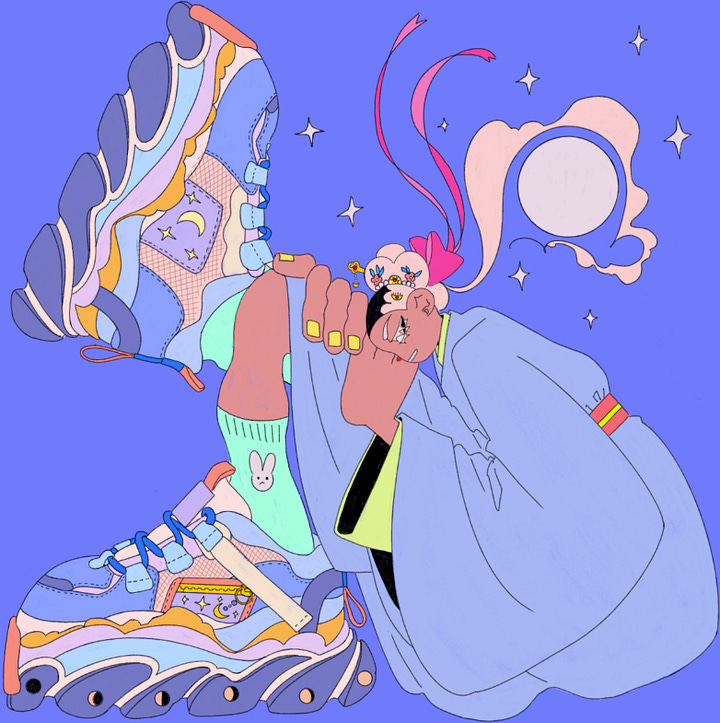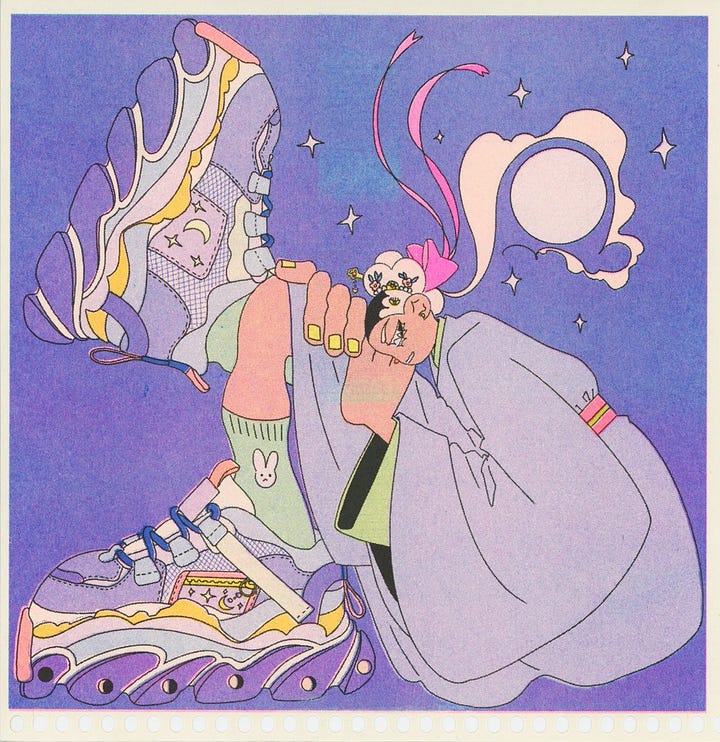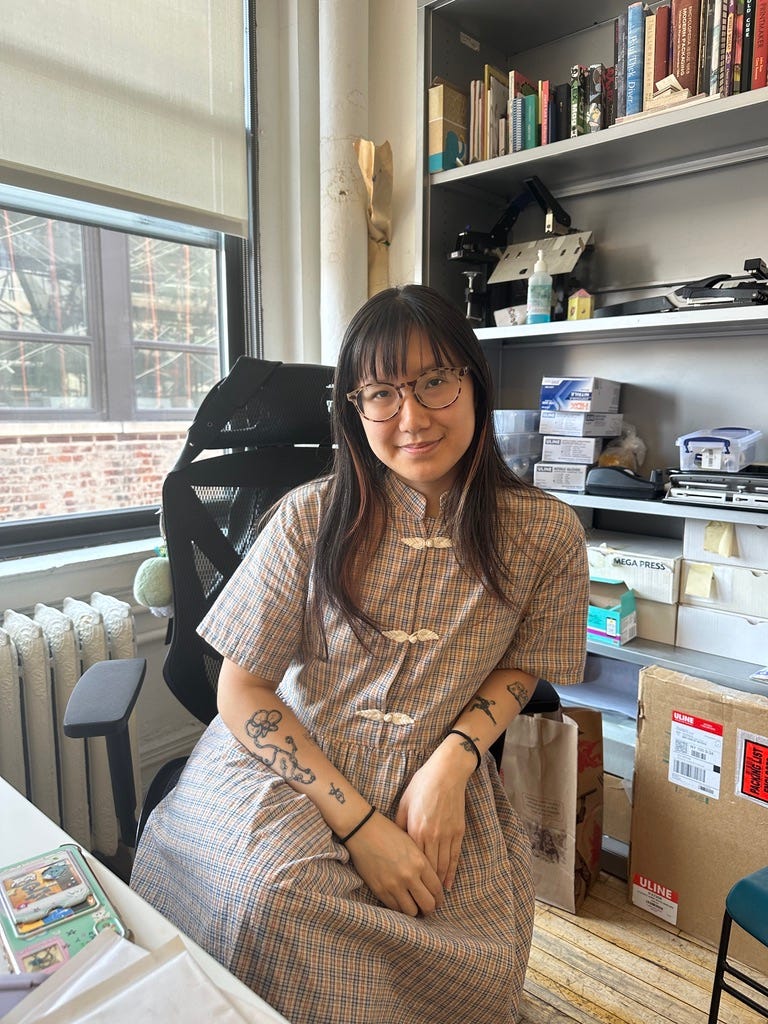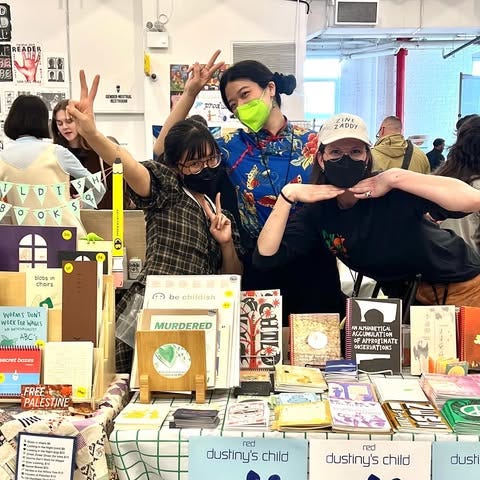Meet My Art Teacher: Sarula Bao
From illustration to small press: dismantling barriers in art publishing
After a nearly yearlong hiatus, Meet My Art Friend is back! This is my interview series where I chat with artist friends about their creative projects, practice, and everything in between.
Today I’m excited to introduce you to Sarula Bao, who taught the ten week risograph workshop I recently took at the School of Visual Arts. Based in Brooklyn, NY, Sarula has had a multifaceted career as an illustrator, zine maker, and community organizer. I first discovered Sarula through her risograph New Yorker covers, so I was both surprised and pleased to see how her practice has since evolved from personal illustration to community-focused teaching and leadership.
Read on to learn more about Sarula’s story and how she now focuses on removing barriers of entry for artists!
Meet Sarula Bao
Carolyn: Your career has evolved from primarily illustration to community building through Endless Editions and Brooklyn Art Book Fair. Were there any pivotal moments that brought on this transition?
I started with Endless Editions in 2018. Joining Endless was one of the best decisions I ever made. I had already been in small press and tabling at fairs before that, but I was literally printing stuff on inkjet printer and everything looked really terrible.
I joined Endless Editions as a work exchange volunteer and now I run that program. Volunteers exchange their labor for [education]. We teach them how to risograph print and assemble books using all kinds of binding techniques. Volunteers essentially learn how small press works.
During the pandemic, founder and mentor Paul John left Endless Editions to work in the Netherlands. He had us all in a Zoom call saying, “Either you guys take this on or [Endless] will die.” A bunch of us stepped up to help, but over time it became clear I was the one most invested in this project.
I started directing Endless Editions around 2021 and also got involved with Brooklyn Art Book Fair (BKABF), helping to organize in prior years and stepping into a director role starting 2022. I really couldn’t bear to let [either] go.
I also started working at SVA’s RisoLAB in 2020. I spend a lot of my time now on programming and community organizing, and I feel this is where my passion and values lie. I really care about investing my time in supporting other artists, especially young, emerging, and underrepresented artists. Because I'm curating and supporting artists, this work is still really creatively fulfilling, even if I don’t draw as much.
Were you still working as an illustrator during this time of transition?
I previously had been working a lot in illustration, but I got really bad tendonitis and carpal tunnel in both of my hands during the pandemic. It was so bad that for eight months, I couldn’t draw, read a book, or play a video game. Cooking was difficult. I couldn’t go on my phone—I had to have voice control activated for everything. It was a very holistic issue, starting with my posture. It was a pretty terrible time.
That sparked my departure from drawing and making illustration my full time career. It was exhausting and bad for my eyesight too.
Illustration is such a specifically physical act.
It’s very physically demanding because you have to sit in front of your screen, doing micro movements with your wrist back and forth. And if you’re doing it with bad posture, it really damages your nerves over time. All of my [forearm and wrist] muscles were inflamed, and I still have issues. The problems are probably going to be with me for the rest of my life.
What does your personal art practice look like now?
I very rarely make personal work. I take on freelance occasionally if the opportunity is hard to turn down or if it’s genuinely interesting.

Your work emphasizes removing barriers of entry for artists, such as BKABF not charging exhibitor table fees. What were some barriers you encountered in your own career that you’re most passionate about addressing?
As an artist, it’s difficult to get your work out there and to have the means to learn. You personally know that taking a continuing education class at RisoLAB is $750. I never would have been able to afford that, so I would have just said, “Okay, then I’m not going to learn.” That’s why I’m really thankful I found Endless when I did. I wouldn’t have been able to try risograph printing otherwise.
I’ve tabled at a lot of book fairs, so I know what it’s like when the table fee is $170 and I make maybe $50. I remember feeling frustrated that I spent so much time and energy and labor, buying nice paper and special materials, paying for the Uber to bring my stuff to the fair, and still having to pay the table fee and not make much money back.
It’s not to say those experiences were a waste of time because I learned a lot from them. I still got to meet and talk to people and to experience selling my own work. But I think about those experiences and I know that they are burdensome. Exhibitors often ask each other in the fair world, "Did you break even?"
As if that’s the success!
Exactly. Breaking even is just the bare minimum of what you need to sustain the project. So I like to think, what if you just didn't have to think about that at all? If there isn't a table fee, you don't need to worry about breaking even. You can just focus on connecting with people, being present and hopefully selling some work. If you don't, it's okay. We'll pay you. That's why [at BKABF] we redistribute our funds to make sure you make at least twenty dollars an hour, or $450 over the course of the weekend.
We have a travel stipend if you can’t afford travel. It’s not just for people who are far away. We’ve had people from the Bronx ask for the stipend because they can’t afford the Uber cost. We try to make it so that the artist doesn’t have to think about these costs and can purely enjoy the experience of connecting with others. Community is so important, and connection to other people is super important in the book world.
That’s why we do this. It shouldn’t be about making money. It shouldn’t be that you’re worried that you can’t make money so you don’t apply to the fair.

You see a lot of new artists’ work through running BKABF. What would be your main advice for artists entering the zine/small press world?
My biggest advice is to connect with other people. Connect with your fellow fair mates and exhibitors. You should get to know your neighbors, talk to people, and buy stuff. Pass the same five or ten dollars back and forth between each other or do a trade. Connecting with your community will make you a better artist and zine maker.
Ultimately, you have to keep making work. Something important to think about is what do you keep going back to? What’s really interesting to you? What ideas keep popping up? Really notice your own work and other people’s work.
When going through applications, do you select exhibitors mainly on artistic merit? What are some other considerations?
The first thing I look at is if they are emerging or underrepresented. At BKABF we want to platform people who might experience the most barriers or have the most difficulty getting their work out there, especially because it’s free.
We look pretty extensively at everything given to us in the application, and even go through people’s Instagram accounts to find out as much as we can. If you have 20,000 Instagram followers and regularly sell a lot of work, we’re probably not going to accept you in the fair. If you’ve got 500 followers and have great work, that’s ideal for us.
We really like political work. It’s not required, but we like it if you’re serving a community in some way. The art itself has to be fresh—not just technically proficient, but something new and interesting that represents the direction the art book scene is moving toward. We also like local artists.
Artists need to have enough work—at least eight books. We need to see a lot of work for the free table to be worth giving. It’s very rare to let in an individual artist [for this reason]. Usually tables go a press or a collective, because those represent more people. You have a stronger chance if you get together with friends and apply together.
Shifting gears, I want to talk a bit about your personal art. I loved coming to your class and admiring your outfits each week. I can see you really love playing with fashion, which comes through in your art as well. Tell me more about how fashion influences your creativity.
A lot of the fashion I draw is wish fulfillment. They’re things I wish I could wear or wish existed, so I’ll draw it to give it life. My main influences are definitely contemporary trends, whether it’s street fashion or designers. I love Chinese historical fashion as well, such as playing with hanfu from all different dynasties. There’s so much to play with pulling from different sources and cultures and mashing them together.


Much of your personal work considers traditional Chinese art and culture and reimagines it. Where do you feel the boundary lies between respectfully reinterpreting and going too far?
The main thing I think about is, does this perpetuate anything harmful?
Growing up in the States, you know what Orientalist imagery looks like. You will never catch me drawing a sexy dragon lady in a cheongsam. There’s a lot of imagery prevalent in the States that perpetuates stereotypes. That’s something I actively want to combat by only drawing references from Chinese sources that reflect the actual art of the time period.
I want to accurately reflect and honor a Chinese sensibility. I respect myself and my people, and I don’t want to do anything that cheapens our image. Stuff made in America with an Orientalist intention is violence, and I’m not interested in perpetuating violence. I want to make sure that I’m pulling from the right sources, even if it’s playful and not historically accurate. It’s still coming from a lens that is true to being in a space of play as opposed to creating a harmful character.
What unexpected surprises have emerged from your new direction that wouldn't have developed if you'd remained focused primarily on illustration?
Definitely friendships and community. I love being able to provide space for people to find joy in print and connect with one another. I’ve seen people really shine over time, especially with risograph, and that’s really special. Not only have I been able to make a lot of great friends, but other people have made a lot of great new friends as well.
Huge thanks to Sarula for sharing her story and insights with us! You can find more of Sarula’s work on her website and Instagram, as well as through her small press Endless Editions.
Brooklyn Art Book Fair is on hiatus this year (normalize taking breaks 👏) but you can subscribe to Endless Editions' newsletter for updates on smaller programs and workshops.
If you have any questions for Sarula or want to suggest an artist for a future Meet My Art Friend interview, leave them in the comments!







Loved getting to know Sarula a bit! Found her work on IG and it’s so good. I admire her being good at organizing and leading.
This was awesome Carolyn!
Although the reason behind it was heavy, I LOVED reading about Sarula's transition from full-time illustrator to community builder.